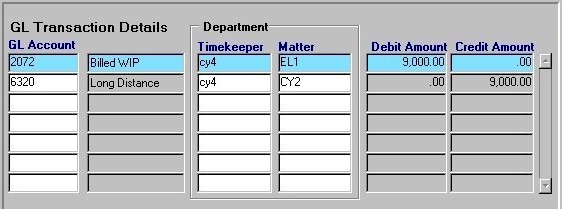Create Recurring Journal Entries
The Create Recurring Journal Entries routine is used to create and/or modify information about General Ledger Journal entries that occur on a monthly basis. To view or edit existing records, the user can execute a query, and then scroll through the records using the Next and Previous record buttons. Because the system stores information about these recurring entries, the user is not required to enter repeat data for the posting of each transaction.
Note: While the Recurring Journal Entry information is maintained through this routine, the Recurring Journal Entries are actually posted through the Post Recurring Journal Entries routine. The information that is entered in this routine will automatically appear in the Post Recurring Journal Entries routine.
When the Create Recurring Journal Entries routine is accessed from the eQuinox main menu, the screen shown below will be displayed.
Field Definition

Group Id - The assigned ID for the group of Recurring Journal Entries. When entering information about a new group of recurring journal entries, the ID is automatically assigned but the user must enter the Description.
Description - A description of the group to which the Recurring Journal Entries belong (i.e. Monthly Deprecation).
Last Posted Date - The date the last transaction of this type was posted to the General Ledger through the Post Recurring Journal Entries routine. This date is for display purposes only and cannot be edited or updated by the user. If the current record is for a new Recurring Journal entry that has yet to be posted, this field will remain blank.
Next Posting Date - The date the next transaction of this type is to occur. The date may be selected from the calendar that appears when the user clicks the list of values button.
Total Debits, Total Credits - The total amount debited and credited to General Ledger accounts (accounts specified below) each time a transaction of this type occurs. These fields are automatically filled in once the user has entered the Debit Amount and Credit Amount, shown below.

General Ledger Account - The number of the General Ledger Account that is either debited or credited during the transaction. The account may be selected from the list of values provided. Both the account number and the account description/name are displayed.
Timekeeper Department - The Timekeeper Department with which the transaction is associated. The information may be selected from the list of values provided. Once a selection is made, the corresponding Department Name, and the Office which houses the Department will be displayed below.
Matter Department - The Matter Department with which the transaction is associated. The information may be selected from the list of values provided. Once a selection is made, the corresponding Department Name, and the Office which houses the Department will be displayed below.
Debit Amount, Credit Amount - The amount that is debited or credited to the specified General Ledger Account during the transaction. The sum of the debit amounts MUST match that of the credit amounts, and for any one record the debit and credit amounts cannot both equal zero. These amounts will be displayed in the Total Debit and Total Credit fields at the top of the screen.

Timekeeper Dept, Office - The name of the Timekeeper Department and the name of the Office that houses this department This information is for display purposes only, and is based on the selection made in the Timekeeper Department field above.
Matter Dept, Office - The name of the Matter Department and the name of the Office that houses this department This information is for display purposes only, and is based on the selection made in the Matter Department field above.
If the user has made any changes to existing records, or has entered new records, they must click the save button or press F10 before the information will be committed.